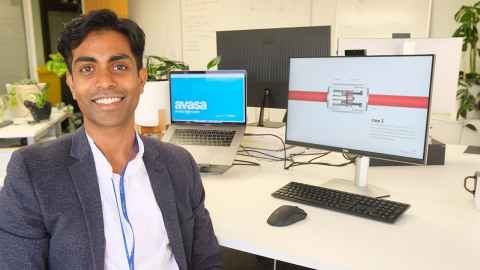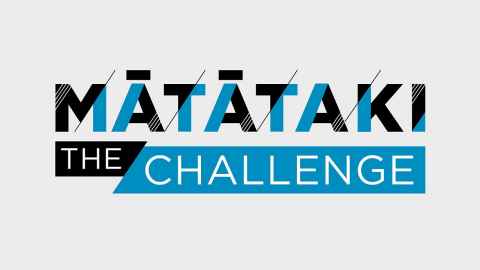Joined up thinking to spark revolution in surgery
23 March 2023
Batman fan turned inventor Nandoun Abeysekera is developing a device to make micro-surgery faster and safer for patients.

Imagine if you had to hand-sew one piece of garden hose to another to connect them. Now imagine you have a few to do, and if you don’t do them quickly and correctly, your lawn could die. Oh, and make the hoses 1.5 to 4mm in diameter.
It may sound ridiculous, but this the sort of thing surgeons do in reconstructive surgery. For example, breast reconstruction surgery involves bringing in tissue from another part of the patient’s body and connecting the veins and arteries so bloodflow – and therefore tissue life – can be maintained. These types of surgeries can take as long as 16 hours.
As a plastic surgery resident, Dr Nandoun Abeysekera took part in many microvascular surgeries. There was a coupler to connect veins – a device comparable to the ring you use on garden hoses. However, there was nothing for arteries.
Veins are the blood vessels that take oxygen-poor blood back to the heart. They’re thin and stretchy. Arteries bring oxygen-rich blood from the heart to the rest of the body. They have a thicker and stiffer muscular wall to withstand the pressure of the heart’s pumping.
If surgeons were to use vein couplers on arteries, they would risk introducing vascular injuries such as tearing the vessel’s wall. This could result in thrombosis – clots blocking blood vessels – or leaks. A clot could result in the death of the transplanted tissue.
Currently, arteries are hand-sewn. However, this is technically sensitive and time-consuming – 40 to 60 minutes to reconnect a single artery. Failure rates are three to five percent.
Abeysekera figured there had to be a way to create a coupler that would work on arteries and thus make microvascular surgery quicker and safer.
Batman in that universe had the coolest suit. It augmented all human functioning through tech, which got me interested in what you could do with the human body.
Abeysekera was always interested in engineering – it was what his father did. A rocket lover as a young child, his interests shifted to civil engineering when he was older as he helped his dad with renovation projects around the family’s Auckland home.
Then, in his teens, he became interested in bioengineering – inspired by none other than the cartoon show Batman of the Future.
“Batman in that universe had the coolest suit,” says Abeysekera. “It augmented all human functioning through tech, which got me interested in what you could do with the human body.”
A bright teen, Abeysekera went to the University of Auckland at 17 and pursued an accelerated pathway that allowed him to complete a Bachelor of Biomedical Engineering at age 19. After that, interested in medicine for its opportunities to connect with people and alleviate suffering, he entered med school.
When, as a surgical resident, he had the idea of developing an arterial coupler, he wasn’t without support. He’d maintained contact with bioengineering professors Poul Nielsen and Andrew Taberner, and Jon Mathy, his mentor in plastic surgery, had a background in biodesign, held patents and understood medical device commercialisation. With the ability to bounce ideas off these mentors as well as an industrial designer friend, Hans Kim, Abeysekera’s arterial coupler design began to take shape.
Entrepreneurship
Abeysekera has benefited from institutional support too. He has an honorary academic position at the Auckland Bioengineering Institute (ABI), which allows him to collaborate with scientists and access the resources of Waipapa Taumata Rau, University of Auckland.
Early on, people at ABI put him in touch with UniServices, the research application and commercialisation company of the University. Senior commercialisation manager Kent Lee encouraged him to pitch his idea to a Return On Science investment committee, which awarded him pre-seed funding to develop the idea further. Abeysekera’s fledgling company, Avasa, was incorporated in 2018.
Another major source of help came through the Velocity $100K Challenge run by the University’s Centre for Innovation and Entrepreneurship. Avasa won the New Ventures prize in 2018, which allowed him to take part in the Venture Lab incubator programme.
“Little did I know that this would change the entire shape and trajectory of the company,” says Abeysekera. “Nobody really teaches you entrepreneurship in medicine or engineering, so I started this project in the best way I knew how. Turns out there was a lot I didn’t know.”
Abeysekera was introduced to mentors who had deep experience in medical device commercialisation and who – helpfully – poked holes in what he was doing.
“The Velocity programme really changed the way I understood this project and helped define some of the goals and directions of the company. The material I produced, like the business proposal, is still relevant today, five years later,” he says.
Today, Avasa is based in Cloud 9, ABI’s ninth-floor incubator space. The company raised funds through a 2022 seed round led by Bridgewest and now employs two engineers in addition to Abeysekera, who left surgery in 2018 to pursue his start-up, though he still works part-time as a general practitioner to keep an oar in the clinical area.
FDA talks
It took Abeysekera years of iterations to come up with a design he was confident about. His arterial coupler relies on eversion – exposing the inner lining of the vessel – to facilitate connection with another artery.
Pins lock each side in place, so the artery connection procedure only takes five minutes. Made of biocompatible materials, Abeysekera believes the device will be proven safe to leave in the body, as vein couplers are.
In 2021, Abeysekera successfully carried out a live animal study in which his arterial coupler was used to reconnect a pig’s 3mm femoral artery and re-establish blood flow.
“That was amazing. It was a surreal moment seeing years of work realised in a live study that very closely mirrored what you’d encounter in human reconstructive microsurgery,” says Abeysekera.
Avasa has started conversations with the U.S. Food and Drug Administration (FDA) and has established a fast regulatory pathway for clearance in the States. Abeysekera expects to have enough data for an FDA submission around the second quarter of 2024.
There’s still a lot of testing ahead before the device can be certified – more animal studies, biocompatibility testing, sterilisation validation – as well manufacturing details to work out. If all goes to plan, Avasa’s device should enter the US market by the first or second quarter of 2025.
It’s a long road – longer than Abeysekera expected – but the same vision that led to the project still drives him.
“Patients will have safer surgeries,” he says. “They’ll experience fewer complications. Surgeons will be able to perform reconstructive microsurgery safely and efficiently, so they’ll be able to do more. Different types of surgeons will be able to do these surgeries as well because of the simplification of the process.”
In future, Abeysekera says he expects the scope of his device to expand to other surgical fields such as organ transplants, cardiothoracic surgery and vascular surgery. “I want to keep innovating and solving problems to improve health outcomes for people.”
Writer: Karen Kawawada
Mātātaki|The Challenge is a continuing series from the University of Auckland about how our researchers tackle some of the world's biggest challenges. Challenge articles are available for republication.
For re-publication requests: Gilbert Wong, Research Communications manager gilbert.wong@auckland.ac.nz
